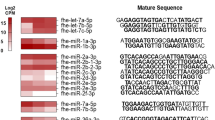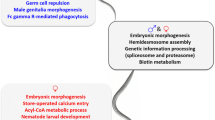Abstract
MicroRNAs (miRNAs) are a class of endogenous non-coding small RNAs regulating gene expression in eukaryotes at the post-transcriptional level. The complex life cycles of parasites may require the ability to respond to environmental and developmental signals through miRNA-mediated gene expression. Over the past 17 years, thousands of miRNAs have been identified in the nematode Caenorhabditis elegans and other parasites. Here, we review the current status and potential functions of miRNAs in protozoan, helminths, and arthropods, and propose some perspectives for future studies.
Similar content being viewed by others
References
Abbott AL, Alvarez-Saavedra E, Miska EA, Lau NC, Bartel DP, Horvitz HR, Ambros V (2005) The let-7 microRNA family members mir-48, mir-84, and mir-241 function together to regulate developmental timing in Caenorhabditis elegans. Dev Cell 9:403–414
Abed M, Ankri S (2005) Molecular characterization of Entamoeba histolytica RNase III and AGO2, two RNA interference hallmark proteins. Exp Parasitol 110:265–269
Abrahante JE, Daul AL, Li M, Volk ML, Tennessen JM, Miller EA, Rougvie AE (2003) The Caenorhabditis elegans hunchback-like gene lin-57/hbl-1 controls developmental time and is regulated by microRNAs. Dev Cell 4:625–637
Adam RD (2001) Biology of Giardia lamblia. Clin Microbiol Rev 14:447–475
Aitcheson N, Talbot S, Shapiro J, Hughes K, Adkin C, Butt T, Sheader K, Rudenko G (2005) VSG switching in Trypanosoma brucei: antigenic variation analysed using RNAi in the absence of immune selection. Mol Microbiol 57:1608–1622
Al Riyahi A, Al-Anouti F, Al-Rayes M, Ananvoranich S (2006) Single argonaute protein from Toxoplasma gondii is involved in the double-stranded RNA induced gene silencing. Int J Parasitol 36:1003–1014
Ambros V (2003) MicroRNA pathways in flies and worms: growth, death, fat, stress, and timing. Cell 113:673–676
Aurrecoechea C, Brestelli J, Brunk BP, Carlton JM, Dommer J, Fischer S et al (2009) GiardiaDB and TrichDB: integrated genomic resources for the eukaryotic protist pathogens Giardia lamblia and Trichomonas vaginalis. Nucleic Acids Res 37:D526–D530
Banerjee D, Slack F (2002) Control of developmental timing by small temporal RNAs: a paradigm for RNA-mediated regulation of gene expression. Bioessays 24:119–129
Bentwich I, Avniel A, Karov Y, Aharonov R, Gilad S, Barad O et al (2005) Identification of hundreds of conserved and nonconserved human microRNAs. Nat Genet 37:766–770
Berberof M, Pays A, Lips S, Tebabi P, Pays E (1996) Characterization of a transcription terminator of the procyclin PARP A unit of Trypanosoma brucei. Mol Cell Biol 16:914–924
Best A, Handoko L, Schluter E, Goringer HU (2005) In vitro synthesized small interfering RNAs elicit RNA interference in african trypanosomes: an in vitro and in vivo analysis. J Biol Chem 280:20573–20579
Blackman MJ (2003) RNAi in protozoan parasites: what hope for the Apicomplexa? Protist 154:177–180
Borchert GM, Lanier W, Davidson BL (2006) RNA polymerase III transcribes human microRNAs. Nat Struct Mol Biol 13:1097–1101
Boyle JP, Wu XJ, Shoemaker CB, Yoshino TP (2003) Using RNA interference to manipulate endogenous gene expression in Schistosoma mansoni sporocysts. Mol Biochem Parasitol 128:205–215
Carlton JM, Hirt RP, Silva JC, Delcher AL, Schatz M, Zhao Q et al (2007) Draft genome sequence of the sexually transmitted pathogen Trichomonas vaginalis. Science 315:207–212
Chatterjee R, Chaudhuri K (2006) An approach for the identification of microRNA with an application to Anopheles gambiae. Acta Biochim Pol 53:303–309
Chen XM, Splinter PL, O’Hara SP, LaRusso NF (2007) A cellular micro-RNA, let-7i, regulates Toll-like receptor 4 expression and contributes to cholangiocyte immune responses against Cryptosporidium parvum infection. J Biol Chem 282:28929–28938
Cullen BR (2004) Derivation and function of small interfering RNAs and microRNAs. Virus Res 102:3–9
De S, Pal D, Ghosh SK (2006) Entamoeba histolytica: computational identification of putative microRNA candidates. Exp Parasitol 113:239–243
Ding XC, Weiler J, Grosshans H (2009) Regulating the regulators: mechanisms controlling the maturation of microRNAs. Trends Biotechnol 27:27–36
Du T, Zamore PD (2007) Beginning to understand microRNA function. Cell Res 17:661–663
Gomes MS, Cabral FJ, Jannotti-Passos LK, Carvalho O, Rodrigues V, Baba EH, Sa RG (2009) Preliminary analysis of miRNA pathway in Schistosoma mansoni. Parasitol Int 58:61–68
Grosshans H, Slack FJ (2002) Micro-RNAs: small is plentiful. J Cell Biol 156:17–21
Hussain M, Taft RJ, Asgari S (2008) An insect virus-encoded microRNA regulates viral replication. J Virol 82:9164–9170
Hutvagner G, Zamore PD (2002) A microRNA in a multiple-turnover RNAi enzyme complex. Science 297:2056–2060
Jolly ER, Chin CS, Miller S, Bahgat MM, Lim KC, DeRisi J, McKerrow JH (2007) Gene expression patterns during adaptation of a helminth parasite to different environmental niches. Genome Biol 8:R65
Kim VN (2004) MicroRNA precursors in motion: exportin-5 mediates their nuclear export. Trends Cell Biol 14:156–159
Klase Z, Kale P, Winograd R, Gupta MV, Heydarian M, Berro R, McCaffrey T, Kashanchi F (2007) HIV-1 TAR element is processed by Dicer to yield a viral micro-RNA involved in chromatin remodeling of the viral LTR. BMC Mol Biol 8:63
Krautz-Peterson G, Skelly PJ (2008) Schistosoma mansoni: the dicer gene and its expression. Exp Parasitol 118:122–128
Lagos-Quintana M, Rauhut R, Lendeckel W, Tuschl T (2001) Identification of novel genes coding for small expressed RNAs. Science 294:853–858
Lai EC, Tomancak P, Williams RW, Rubin GM (2003) Computational identification of Drosophila microRNA genes. Genome Biol 4:R42
Lau NC, Lim LP, Weinstein EG, Bartel DP (2001) An abundant class of tiny RNAs with probable regulatory roles in Caenorhabditis elegans. Science 294:858–862
Lee RC, Ambros V (2001) An extensive class of small RNAs in Caenorhabditis elegans. Science 294:862–864
Lee RC, Feinbaum RL, Ambros V (1993) The C. elegans heterochronic gene lin-4 encodes small RNAs with antisense complementarity to lin-14. Cell 75:843–854
Lemos MV, Menezes H (1978) The effect of an immune RNA (RNAi) against Trypanosoma cruzi infection in mice. Tropenmed Parasitol 29:119–126
Lin WC, Haraguchi T, Ozaki Y, Iba H (2009) Identification of microRNA in the protist Trichomonas vaginalis. Genomics 93:487–493
Mallick B, Ghosh Z, Chakrabarti J (2008) MicroRNA switches in Trypanosoma brucei. Biochem Biophys Res Commun 372:459–463
Mead EA, Tu Z (2008) Cloning, characterization, and expression of microRNAs from the Asian malaria mosquito, Anopheles stephensi. BMC Genomics 9:244
Militello KT, Refour P, Comeaux CA, Duraisingh MT (2008) Antisense RNA and RNAi in protozoan parasites: working hard or hardly working? Mol Biochem Parasitol 157:117–126
Omoto S, Fujii YR (2005) Regulation of human immunodeficiency virus 1 transcription by nef microRNA. J Gen Virol 86:751–755
Ong SJ, Hsu HM, Liu HW, Chu CH, Tai JH (2006) Multifarious transcriptional regulation of adhesion protein gene ap65-1 by a novel Myb1 protein in the protozoan parasite Trichomonas vaginalis. Eukaryot Cell 5:391–399
Pascolo E, Blonski C, Shire D, Toulme JJ (1993) Antisense effect of oligodeoxynucleotides complementary to the mini-exon sequence of the protozoan parasite Leishmania amazonensis. Biochimie 75:43–47
Piriyapongsa J, Jordan IK (2007) A family of human microRNA genes from miniature inverted-repeat transposable elements. PLoS one 2:e203
Prucca CG, Slavin I, Quiroga R, Elias EV, Rivero FD, Saura A, Carranza PG, Lujan HD (2008) Antigenic variation in Giardia lamblia is regulated by RNA interference. Nature 456:750–754
Reinhart BJ, Slack FJ, Basson M, Pasquinelli AE, Bettinger JC, Rougvie AE, Horvitz HR, Ruvkun G (2000) The 21-nucleotide let-7 RNA regulates developmental timing in Caenorhabditis elegans. Nature 403:901–906
Rhoades MW, Reinhart BJ, Lim LP, Burge CB, Bartel B, Bartel DP (2002) Prediction of plant microRNA targets. Cell 110:513–520
Ronemus M, Vaughn MW, Martienssen RA (2006) MicroRNA-targeted and small interfering RNA-mediated mRNA degradation is regulated by argonaute, dicer, and RNA-dependent RNA polymerase in Arabidopsis. Plant Cell 18:1559–1574
Roush S, Slack FJ (2008) The let-7 family of microRNAs. Trends Cell Biol 18:505–516
Ruby JG, Jan CH, McConkey GA (2007) Intronic microRNA precursors that bypass Drosha processing. Nature 448:83–86
Saraiya AA, Wang CC (2008) snoRNA, a novel precursor of microRNA in Giardia lamblia. PLoS Pathog 4:e1000224
Schier AF, Giraldez AJ (2006) MicroRNA function and mechanism: insights from zebra fish. Cold Spring Harb Symp Quant Biol 71:195–203
Simon-Mateo C, Garcia JA (2006) MicroRNA-guided processing impairs Plum pox virus replication, but the virus readily evolves to escape this silencing mechanism. J Virol 80:2429–2436
Slack FJ, Basson M, Liu Z, Ambros V, Horvitz HR, Ruvkun G (2000) The lin-41 RBCC gene acts in the C. elegans heterochronic pathway between the let-7 regulatory RNA and the LIN-29 transcription factor. Mol Cell 5:659–669
Smibert P, Lai EC (2008) Lessons from microRNA mutants in worms, flies and mice. Cell Cycle 7:2500–2508
Solis CF, Guillen N (2008) Silencing genes by RNA interference in the protozoan parasite Entamoeba histolytica. Methods Mol Biol 442:113–128
Tang GQ, Maxwell ES (2008) Xenopus microRNA genes are predominantly located within introns and are differentially expressed in adult frog tissues via post-transcriptional regulation. Genome Res 18:104–112
Tang G, Zamore PD (2004) Biochemical dissection of RNA silencing in plants. Methods Mol Biol 257:223–244
To WY, Wang CC (1997) Identification and characterization of an activated 20S proteasome in Trypanosoma brucei. FEBS Lett 404:253–262
Wienholds E, Plasterk RH (2005) MicroRNA function in animal development. FEBS Lett 579:5911–5922
Wightman B, Ha I, Ruvkun G (1993) Posttranscriptional regulation of the heterochronic gene lin-14 by lin-4 mediates temporal pattern formation in C. elegans. Cell 75:855–862
Winter F, Edaye S, Huttenhofer A, Brunel C (2007) Anopheles gambiae miRNAs as actors of defence reaction against Plasmodium invasion. Nucleic Acids Res 35:6953–6962
Xue X, Sun J, Zhang Q, Wang Z, Huang Y, Pan W (2008a) Identification and characterization of novel microRNAs from Schistosoma japonicum. PLoS One 3:e4034
Xue X, Zhang Q, Huang Y, Feng L, Pan W (2008b) No miRNA were found in Plasmodium and the ones identified in erythrocytes could not be correlated with infection. Malar J 7:47
Zamore PD (2002) Ancient pathways programmed by small RNAs. Science 296:1265–1269
Zhang B, Farwell MA (2008) microRNAs: a new emerging class of players for disease diagnostics and gene therapy. J Cell Mol Med 12:3–21
Zhang YQ, Chen DL, Tian HF, Zhang BH, Wen JF (2009) Genome-wide computational identification of microRNAs and their targets in the deep-branching eukaryote Giardia lamblia. Comput Biol Chem 33:391–396
Zhao T, Li G, Mi S, Li S, Hannon GJ, Wang XJ, Qi Y (2007) A complex system of small RNAs in the unicellular green alga Chlamydomonas reinhardtii. Genes Dev 21:1190–1203
Acknowledgments
This work is supported, in part, by grants from the National Basic Research Program of China (Grant no. 2007CB513104), National Natural Science Foundation of China (Grant no. 30972178), the National Special Research Program for Non-Profit Trades (Agriculture; Grant no. 200803017), the Program for Changjiang Scholars and Innovative Research Team in University (Grant no. IRT0723), National Key Technology R&D Program of China (Grant no. 2010BAD04B01), and “Gold Idea” Foundation of Institute of Military Veterinary, Academy of Military Medical Sciences (Grant no. YCX0901).
Author information
Authors and Affiliations
Corresponding authors
Rights and permissions
About this article
Cite this article
Liu, Q., Tuo, W., Gao, H. et al. MicroRNAs of parasites: current status and future perspectives. Parasitol Res 107, 501–507 (2010). https://doi.org/10.1007/s00436-010-1927-6
Received:
Accepted:
Published:
Issue Date:
DOI: https://doi.org/10.1007/s00436-010-1927-6




